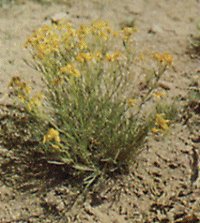RUBBERWEED


Description:
Rubberweed has golden-yellow or orange flowers that resemble asters. Woolly cottonlike fibers are often attached at the crown of the plant. It may reach a height of about 1 foot. The stalk is thick and woody. Stem bases are covered with a wooly growth. Rubberweed belongs to the sunflower family.

Two species of rubberweed may cause serious livestock losses on overgrazed ranges in the summer and fall. Pingue, or Colorado rubberweed, is a perennial. Bitter rubberweed, or bitterweed, is an annual plant.
Poisoning is common in sheep, but occurs only occasionally in cattle. The plant is poisonous to livestock throughout the growing season. Losses are heaviest when hungry animals are trailed through rubberweed from summer ranges or are placed on overgrazed ranges with heavy infestations of rubberweed.
All aboveground parts of the plant contain the poisonous substance. As an animal grazes on rubberweed, the toxic substance builds up gradually.

Where and When It Grows
Rubberweed grows in dry soils at elevations of 6,000 to 8,000 feet. It is found mostly on mountains and foothills. It grows from early spring until the first frost.
It is considered an invader plant. As other forage plants are killed by overgrazing, rubberweed takes over the range.

How It Affects Livestock
A 100-pound may die if it eats 1/4 to 1/2 pound of rubberweed daily for 1 to 2 weeks. An animal may die from one large feeding. Most poisoning occurs in spring or fall. In most cases, the first sign to be observed is a green froth around the mouth and nose.

Signs of poisoning
1. Depression
2. Weakness
3. Vomiting
4. Bloating
5. Frothing at the mouth
6. Green discharge at the nose
7. Coma

BACK TO INDEX
H O M E
Would You Consider Signing
My Book?










